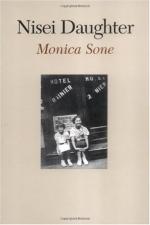|
This section contains 434 words (approx. 2 pages at 400 words per page) |

|
Nisei Daughter Summary & Study Guide Description
Nisei Daughter Summary & Study Guide includes comprehensive information and analysis to help you understand the book. This study guide contains the following sections:
This detailed literature summary also contains Bibliography on Nisei Daughter by Monica Sone.
Monica Sone's Nisei Daughter is a memoir about growing up as a Japanese American in the United States prior to and during World War II. The author, born on American soil to Japanese immigrant parents, is a Nisei, or second-generation Japanese American. Herparents, as first-generation Japanese immigrants to America, are considered Issei. Being born in the United States meant that a Nisei was an American citizen, but strict immigration laws prevented any Issei from becoming citizens until long after World War II.
Nisei found themselves torn between their Japanese ancestry and their thoroughly American lifestyles. They often had to serve as cultural or linguistic interpreters for their Issei parents, many of whom had not fully mastered the English language or American customs. Nisei were often criticized by Japanese nationals for abandoning their roots, yet they were unable to fully assimilate into the American mainstream thanks to widespread fear and prejudice toward the Japanese during the first half of the twentieth century.
As World War II approached, both generations of Japanese Americans faced especially harsh persecution along the West Coast, where most had established roots. Sone recounts her experiences as a young Nisei in Seattle in the years leading up to and shortly after the Japanese attack on Pearl Harbor in 1941. She chronicles the virtual loss of her rights as an American citizen and her family's forced relocation to an internment camp in Idaho. Nevertheless, Nisei Daughter is hardly a bitter or accusatory book. Instead, it focuses on one family's strength in the face of adversity, and their willingness to sacrifice for the benefit of the country they love.
Although readers often focus on the book's depiction of Japanese relocation and internment during World War II, Sone was also one of the first authors to offer a detailed view of day-to-day life as a Japanese American in the 1920s and 1930s. It is through these mundane interactions that Sone illustrates the process of assimilation, wherein members of a minority group adopt the behaviors and attitudes of the majority population among which they live. In Nisei Daughter, the issue of assimilation becomes especially complex. While most Nisei make great efforts to assimilate, a significant segment of the American population seems to resist, and even thwart, these efforts.
While Nisei Daughter was not particularly successful when it was originally published in 1953, renewed interest in the matter of Japanese internment resulted in a 1979 reprint edition through the University of Washington Press. This edition has spawned the book's widespread popularity, and it is often assigned as required reading in many classes dealing with multicultural issues in America.
Read more from the Study Guide
|
This section contains 434 words (approx. 2 pages at 400 words per page) |

|



